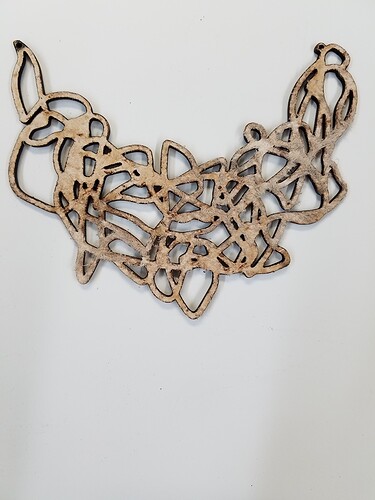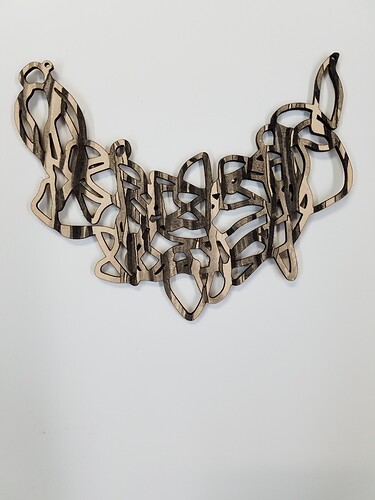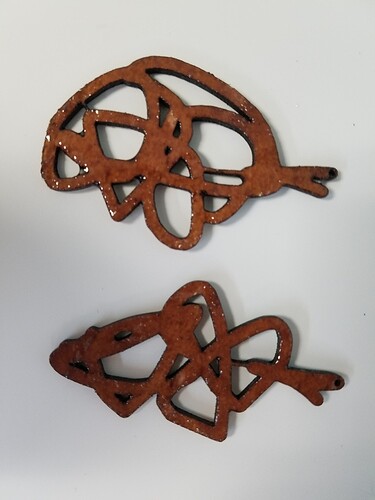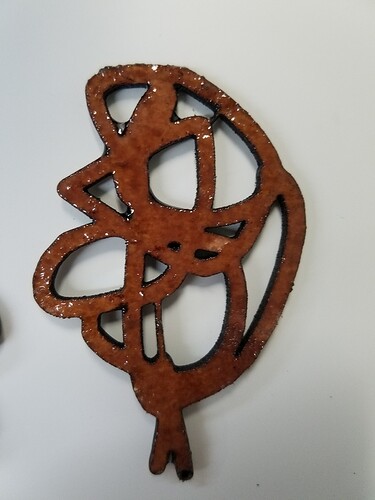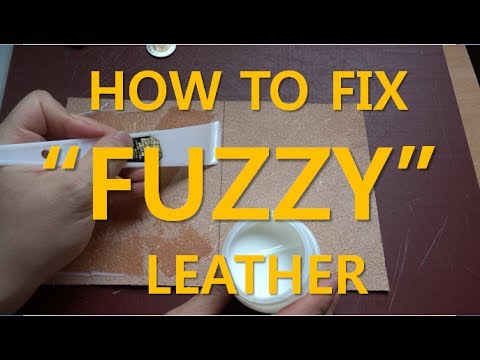If anybody has any ideas on how to make the back of this presentable I am all ears!
Thank you all and this forum is amazing!
1516733604324436611966|666x500
I suppose you could cut them from thin material, then mirror cut a second piece and laminate them together with glue?
This is going to be true of most leather, but you can find leather that is a little more finished looking on the back. E.g. I got some leather from Tandy that I used on my leather tray that has a little more finished look to the back (though it still doesn’t look as good as the front).
You could cut out a mirrored version of the pattern and glue the two pieces back to back maybe. I think its common to use a “lining leather” to cover the inside of leather projects where a more finished look is desired.
btw, can we see a picture of the front?
Tried to upload the front on the main post, but I’m working on my phone so it is being quirky!
Maybe I’ll take an electric razor to the back to try and get the fuzz off later. I’m not even sure how another material would adhere to the back nicely…
That’s just how leather is, particularly thicker pieces. The side that used to be on the outside of the animal (“grain side” or “hair side”) is smooth but the side that faced the inside of the animal (the “flesh side”) is rough. When the flesh side is exposed on a finished product it’s called suede.
Thinner pieces may be just the top-grain split from split leather and won’t be as rough underneath. But thicker pieces are going to have more material from the flesh side, so they are going to be rougher.
A useful resource for learning about leather and the many leather terms is https://www.leather-dictionary.com/
Thank you so much for that! I’ll read up!!
Wouldn’t you basically have to burnish the entire backside to get a finished appearance on that side? Or dye and sand with a very fine grit?
Typical finishing process is to put a lining on the flesh side. Either sown on or contact cemented on or both. The lining can be cloth or a thin leather like pigskin (or other stuff like felt).
Another way to go is to embrace the variation on that side and cut down on the roughness by skiving, dying, and/or burnishing.
For my notebook covers that I don’t need to be particularly waterproof on the inside, I dyed them and then burnished with gum tragacanth. To burnish, I used a 3/8" thick, 4"x6" piece of glass that has it’s edges finished by rounding them over. You run that back and forth over the flesh side with some pressure and speed and it lays down the hairy bits and the gum holds it there more or less. I thought it turned out nice, but I like natural variation in things.
Interesting. I’ve never heard of burnishing leather with a piece of glass. Good to know. I was just about to suggest some gum tragacanth. Another thing is glycerin saddle soap. And lot of leather workers apparently like to use canvas or denim to burnish edges, although I’ve never tried it.
They sell them packaged for the purpose: https://www.tandyleather.com/en/product/glass-burnisher
Edit: Tandy changed their site around, so now (9/2020) the link is:
I don’t think they’re particularly special for the purpose, but you can find YouTubers who wax poetic on the topic of the particular edge, weight, etc.
Pinging the ‘Leather Lady’, @morganstanfield and the amazing leather artist @Drea.
Weird. I’ve done a lot of searching, on YouTube and otherwise, and I’ve never seen mention of a glass burnisher. Learn something new every day.
Sadly no, this doesn’t generally work. If you want both sides to be like the smooth grain side you have to glue two mirrored pieces together or start with a bonded leather that’s made that way (bonded leather is like MDF, extruded leather slurry). It’s just how animal skin is. Use a contact cement like highly flammable Barge or Masters (overkill for this project). If you want something non-toxic the Renia adhesives work GREAT. Easy to get in Europe, the only US distributor I know of is Lisa Sorrell.
Glass burnishing is also an old world technique used on the stacked leather heel sides and edges of fine bespoke shoes 
I think most of the advice I’d have given was already covered by @Cole, @tim1724, @markwal, and @ekla. The only veg-tan leather I know of that has a consistently fuzz-free back side is kangaroo leather from Packer Leather in Australia, but that’s paper thin (well, watercolor paper thin). There are lots of other leathers, such as Tandy’s black pigskin garment suede, that do as well, but they’re all of suspected or confirmed chromium tannage.
If I was trying to solve this problem, I’d experiment with bonding other material on the back of my leather before cutting, and doing the cut in multiple passes, with the final pass or two very gentle, to minimize scorching and backflash. I’d think of it as doing a kiss cut, a la’ vinyl cutting, until that final pass or two that cut through the backing material. Maybe I’d put it on a Seklema mat or other cutting surface to further prevent backflash.
As for bonding a mirror image cutout, getting one to acceptably align with the kind of cuts @jessicajoylondon is doing–and without glue smoodging everywhere–is going to be a nightmare. I wouldn’t even try it unless a bunch of other alternatives (pre-cut bonding, burnishing, alternate leathers) failed. If I had to do it that way, with leather as thick as she’s indicating, I’d create some kind of alignment jig for placing the two pieces of leather together. Of course, that might be a totally unreasonable amount of labor for the final selling price of the item unless I was doing a lot of multiples of the design.
Godspeed on this. Leather fuzz is one of the banes of my existence.
Thanks Morgan.
I have ‘recently learned the term ‘flesh side’ of the leather exhibits this (always knew this was the case) but It gives the term ’ Death Fabric’ a little more perspective. 
Our biosphere is a skin on this planet that feeds on itself. That’s how it works, and we are part of that biological mechanism. I love death fabric, especially the soft stuff.
Thank you all for your thoughtful advice and for bringing in the experts on this! I’m going to sit down with your suggestions this week and do more research. I’m also going to experiment with bonding 2 pieces of medium leather and 1 piece of medium leather to a piece of venir or… putting resin on the back. I’ll check back in with what I find!
Looks like you may have found a happy solution @jessicajoylondon , good news!
For anyone interested in the process of finishing the backside of veg tan leather using Tokonole and a glass slicker, here is a very helpful clip.
I was just reading the msds on barge cement. Looks like it decomposes as CO and CO2 under heat once it’s dry. It appears that the nasty stuff is in the solvents. I’m wondering if it would be safe to bond a thin piece of veg tanned pigskin lining leather, let it set for a few days, then cut.
